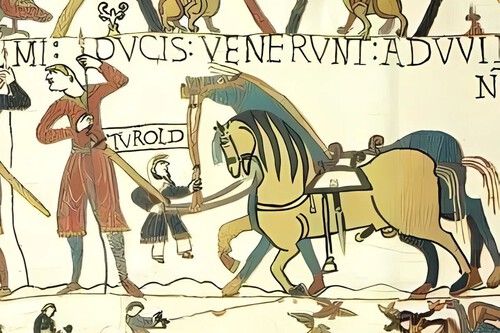Centuries ago, it appears that people were just as captivated with penis drawings as we are today, though that’s not the issue.
When it comes to the 11th century Bayeux Tapestry, which is filled with dozens of penises on men and horses alike, the question is the following: Is it a penis or a scabbard? The answer could settle one of the strangest fights in academia.
The Bayeux Tapestry. Before we talk about the penises, it’s important to introduce the artwork where they appear. The Bayeux Tapestry is a roughly 230-foot-long artwork, which is actually an embroidery, that depicts the events of the Norman Conquest of England in 1066. It pays a particular focus to the battle of Hastings. In that battle, King Harold is defeated by Duke William of Normandy, otherwise known as “William the Conqueror.”
While no one knows the identity of the person or group behind the Bayeux Tapestry, there are some clues available. Scholars believe that it was made in Norman England and was likely created by women because they were the only people who embroidered in medieval England, according to History Extra. However, some experts believe that it’s possible men were involved in creating the design.
 A scene from the Bayeux Tapestry.
A scene from the Bayeux Tapestry.
The penises. Now, onto the penises. Besides depicting the Norman Conquest, the tapestry is full of interesting details. Scholars have gleaned a trove of information about what things were like at the time from the tapestry, from clothing and arms to medieval ship building.
The number of penises in the artwork fall into this category. George Garnett, a professor at Oxford University, counted the number of penises in the tapestry in 2018. (Counting the number of certain objects in the tapestry is an endeavor that has been carried out by other academics, though until then, never penises). Specifically, he found that there were 93 penises in the artwork: 88 attached to horses and 4, or maybe 5, attached to human figures.
According to Garnett, the penises don’t simply mean that the tapestry’s designer “had a hitherto unremarked obsession on his own.” In fact, Garnett believes that it’s not a coincidence that the penises of the horses of the battle’s protagonists, Harold and William the Conqueror, are the biggest in the tapestry.
“The clear implications are that the virility of the two leading protagonists is reflected in that of their respective mounts,” Garnett wrote in an article in 2018.
The missed penis? And so, for years the academic world lived with the assumption that there were 93 penises in the Bayeux Tapestry. However, the theory was recently challenged by another scholar, Christopher Monk, who is a historian specialized in the Bayeux Tapestry.
In a recent episode of the HistoryExtra Podcast, which is only available to paying subscribers, Monk said he had found another penis on the tapestry in the depiction of man running with something hanging under his tunic.
“I am in no doubt that the appendage is a depiction of male genitalia–the missed penis, shall we say?” Monk said. “The detail is surprisingly anatomically fulsome."
But Garnett, the original counter of penises, believes Monk is wrong. What he’s referencing isn’t a penis, the professor said, but rather a scabbard of a sword or dagger. The key, according to Garnett, is the fact that the alleged “missed penis” has a yellow blob at the end, which he understands is a depiction of brass.
“If you look at what are incontrovertibly penises in the tapestry, none of them has a yellow blob at the end,” Garnett said on the podcast.
We all turn when we hear the word “penis.” The discrepancy over the number of penises in the tapestry has become the hot tea of the academic world, with neither scholar appearing to bow out of the fight for now.
To a layperson, this fight between Garnett and Monk might seem silly, but experts say it’s far from it. David Musgrove, the host of the HistoryExtra Podcast, says the possibility of another penis invites scholars to reexamine what they thought they knew.
“It invites us to think again as to why there are these explicit scenes in what is otherwise a story of politics, power, and pitched battle,” he said.
Furthermore, the fact that this discrepancy is over a penis presents another opportunity, one where people far removed from the Bayeux Tapestry can take an interest in it.
“[If] there’s even a mention of penises, suddenly it attracts vast numbers of people who would never dream of opening an academic journal,” Garnett said.
Image | Wikimedia Commons (edited to upscale) | HistoryExtra YouTube (screenshot) | Wikimedia Commons
Related | As Japan Moves Away From Paper Porn, Its Streets Feel the Impact



